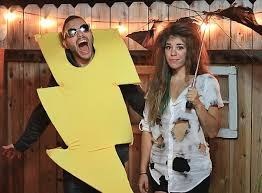View this video on YouTube
To a lot of folks, lightning is high-voltage comedy gold--or the reason killjoy lifeguards used to chase us out of the pool when we were kids....
But get this: lightning is no laughing matter. In fact, it's one of the top storm-related killers and causes a half-billion dollars in property damage in the U.S. each year (source: I.I.I./State Farm).
So what are we supposed to do, stay indoors for the rest of our lives? Only hang out with tall people*** Well, a good first step is to know truth from fiction, starting with the real stories behind these persistent lighting myths--along with a few facts that could keep you safe when the weather turns rough.
(***Another lightning myth...)
MYTH – LIGHTNING NEVER STRIKES THE SAME PLACE TWICE
Fact: Like that old joke, "where do 800 lb. gorillas sleep?", lightning strikes Anywhere (and any TIME) it wants.
At any given moment, there are 1,800 lightning storms happening around the world (source: www.noaa.gov). Among U.S. states, Florida is the state most often hit by lighting, with 25.3 strikes per square mile (source: The Weather Channel). Really, if you think about it, the notion that lighting never strikes the same place twice is kind of silly, considering that there are 16 million lightning storms on earth in an average year!

MYTH – LIGHTNING ONLY STRIKES THE TALLEST OBJECTS
Fact: Lightning is indiscriminate and it can find you anywhere.
It hits homes instead of trees; people, instead of nearby telephone poles; and homes and businesses, instead of skyscrapers.
And not only does lightning not always hit the tallest objects, it may have a preference for the foolhardiest ones, too—young people aged 15–34 years account for almost half of all lightning strike victims (41%) (source: CDC).

MYTH – IF YOU DON'T SEE CLOUDS OR RAIN, YOU'RE SAFE
Fact: ...Or maybe not. Lightning can strike 10 miles from a thunderstorm—this is where we get the expression, "a bolt from the blue" (source: NOAA).
But if you ARE stuck in a thunderstorm, you are NOT safe ANYWHERE outdoors.
In fact, you're not totally safe indoors, either. During a thunderstorm, you should avoid contact with:
•corded phones
•electrical equipment or cords—if you plan to unplug electronic devices, do so only before you hear the first clap of thunder)
•plumbing—do not wash your hands, take a shower, wash dishes, or do laundry. (Come to think of it, lighting storms do have their upsides...)

MYTH: IF YOU TOUCH A PERSON WHO'S BEEN STRUCK BY LIGHTNING, YOU'LL BE ELECTROCUTED, TOO!!!1!
Fact: Okay, we'd like to be serious for a moment: The human body doesn't store electricity. so it's perfectly safe to touch a lightning strike victim to give them first aid.

If there's one essential thing you need to know about lightning, it's this:
FACT: WHEN THUNDER ROARS, GO INDOORS!
For more facts about lightning and safety tips, visit the Lightning Protection Institute: Lightning.org.


